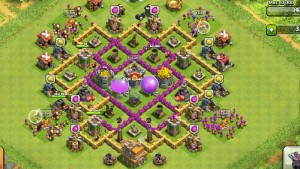Clash of Clans: Network effects and stickiness in mobile gaming

A view of how network effects apply to one of the most popular mobile games.
Mobile gaming is the new trend that many gamers are following nowadays, and Clash of Clans is one of the most popular titles available. Following a “Freemium” model, this game reports more than $1 million dollars per day to its developing studio – Supercell – and has reached a scale of about 100-500 million installations and more than 2 million daily players.
Value creation
With a product design meant to attract both casual and hardcore gamers and an online multiplayer battle system, this app has caught the attention of millions of users who play daily and also bring friends to the platform to play with them in their “clans”. In the game, players build a village from scratch and troops to defend it. Once in a clan, players can help each other with troops and can share replays of their battles against other players in the network. This is when direct network effect are most visible, given that the presence of new players enhance the gaming experience for current players and make the game more attractive to play.
Value Capture
The game, makes its money by offering optional items (i.e. Gems) through apple store/google play. Although this items are not strictly necessary to move on in the game, they greatly help players to advance faster and catch up with other friends that started before them.

The popularity of this game has been so big, that new external sources of revenue have appeared to capitalize on this success, generating indirect network effects and enhancing the in-game experience for current users. Hundreds of blogs, youtube videos and even apps have appeared to offer strategies, hints and even free gems to users. A clear example is Chief Pat’s Youtube channel. With over a million subscribed users watching his weekly videos, he earns over $100.000 a year for his content plus “sponsorship” from advertisers to buy in-game items, transferring part of the advertising revenues to Supercell.
Besides the effects on current users, these third parties generate tons of “free marketing” for the game by filling social networks with shares of their posts and videos. This certainly contributes to increment the current user base making this a virtuous cycle for them, the studio and the gamers.
Competition
Many game studios have tried unsuccessfully to introduce similar games to the market in the last few years. They offer very good design, faster improvement of villages, and cheaper in-game items that Clash of Clans, but is just too late. Being a really addicting type of game, users usually only have time to spend on of them and they have already chosen. Once you have all your friends playing with you in a game that updates and offers new things from time to time, there is no reason to change!
This speaks to the importance of achieving scale quickly when in presence of network effects. Clearly, the platform that gets most of the market share will generate more dependency on it through the network effects exposed before making it costly for the users to substitute even if better products are introduced by the competition (start over, make your friends follow, etc).
Summary
As seen in Clash of Clans, the network effects also allow to create value for users and also for 3rd parties which in turn will capture value from advertisers and transfer part of it to your platform.
Although network effects help your business to achieve scale and earn revenues at a fast pace, being the first to achieve scale is critical for sustained success. This can be done through a very solid/addicting product, with “Freemium” revenue models and of course, with marketing. Once the scale is achieved, a focus on updating the product offering by copying good ideas and/or incorporating users’ feedback, should be enough to keep on with a very successful formula.





Their model to make money based on micro-transactions is brilliant. While I don’t play “Clash of Clans”, I have played other games where its very easy to justify spending $1 to catch up to a friend or getting that extra sweet building that everyone else is jealous of and just has to buy for themselves. I bet if people looked carefully at their credit card statements they’d be horrified how much money they’ve cumulatively put into a silly mobile game just to gain instant gratification.
The key to the game is the “Clans” part though. Human beings are psychologically inclined to codify themselves into groups for a sense of belonging and even defense (street gangs). The fact that the game has both component is crucial to attracting and maintaining a large user base. You’re right that other games are just too late, well, at least direct competitors are too late. CoC is just another incarnation of Mafia Wars or Farmville. It will fade and be replaced by another GDP-sapping digital distraction within a year or two. I shudder to think what the next one will be. Altercation of Agriculture? Harmville? Angry Kurds?
Love this whole space — fascinating as to which games end up successfully capturing player mindshare. I agree that these games end up taking off when they master the art of network effects, and scale to a point where growth then becomes exponential. It was fascinating relatedly to see games such as Candy Crush in fact requiring users to help promote network effects in order for that user to unlock extra game capabilities for themselves. By asking users to share to their friends or pay money, Candy Crush successfully prompted network effect behavior. What is worth watching to me is the turning point at which users get turned off by prompted sharing, and instead favor more organic forms.
Thanks for a great post. As you correctly indicated, allowing users to form a ‘clan’ and, thus, enabling users to actively communicate with each other has been a great way to increase the platform’s stickiness. Moreover, I think Clash of Clan is an example that shows that heavy investment in marketing coupled with the product’s outstanding quality is a way to accelerate the creation of the networking effect. Wonder how Supercell will deal with the trend-sensitive nature of the game industry and maintain the game’s popularity.
As one of those 2 million daily Clash of Clans players, I completely agree that direct network effects are a critical factor in the game’s popularity and stickiness. While I do not have the retention statistics, I am confident that few if any other mobile games have achieved as high a level of sustained user engagement over time as Clash.
I believe the success of Clash of Clans comes from not only the presence of direct network effects but also from their unusual strength: in Clash, direct network effects take the form of social pressure to continue playing in order to contribute to the success of your clan (which may contain some of your real-life friends as well). This is unlike most other mobile games, which may incorporate some weak direct network effects but rarely can achieve such strong direct network effects. For this reason, I would guess that user retention in Clash is highly correlated to user membership in a Clan. I would love to get the usage data and test this hypothesis!